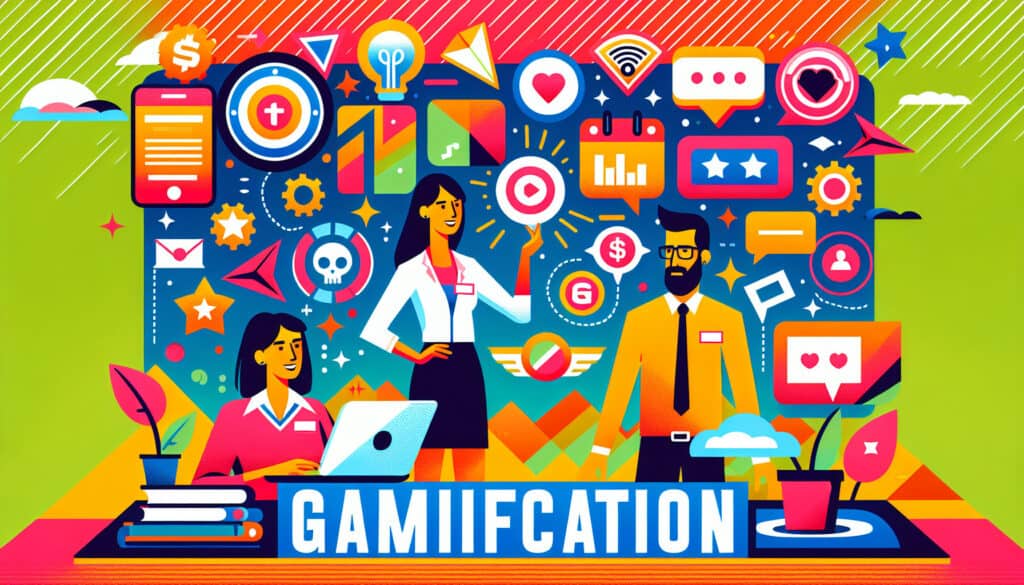To apply game-design elements and principles in non-game contexts.
- Méthodologies : Ergonomie
Gamification

Gamification
- Conception comportementale, Expérience client, Pensée conceptuelle, Système de gestion de l'apprentissage (LMS), Expérience utilisateur (UX), Interface utilisateur (UI)
Objectif :
Comment il est utilisé :
- The use of game mechanics like points, badges, leaderboards, and challenges in products and services to increase user engagement and motivation.
Avantages
- Can increase user engagement and motivation; Can make tasks more enjoyable.
Inconvénients
- Can be perceived as manipulative if not done well; May not be effective for all users or contexts.
Catégories :
- Clients et marketing, Conception de Produits
Idéal pour :
- Increasing user engagement in a fitness app or a learning platform.
Gamification has wide applications across various sectors, including healthcare, education, and corporate training, where client engagement is essential. For instance, in the healthcare sector, gamification can be integrated into patient management systems, encouraging individuals to adhere to their medication schedules through points or rewards for compliance, resulting in better health outcomes. In educational contexts, platforms like Duolingo deploy game-like features such as streaks and levels to motivate learners and enhance retention, making the learning experience both enjoyable and effective. Organizations can also utilize gamification in workforce training programs, implementing simulations or leaderboards that not only promote skill acquisition but also foster healthy competition among employees, enhancing productivity. This methodology works best when championed by stakeholders in product design and development, such as UX designers, product managers, and marketing teams, who can collaborate to create engaging experiences that resonate with users. Stakeholder feedback and user testing play a significant role in refining gamified elements, ensuring they align with user preferences while promoting desired behaviors. The integration of game mechanics can also shift user perceptions, making mundane tasks feel more rewarding and less laborious, thereby increasing compliance and satisfaction rates within applications.
Principales étapes de cette méthodologie
- Define objectives for engagement and motivation in the fitness app or learning platform.
- Identify target user behaviors and desired outcomes that align with objectives.
- Select appropriate game mechanics that suit the user base and the application context.
- Design and implement points systems, badges, and leaderboards specific to targeted actions.
- Create challenges and quests that are relevant and encourage user participation.
- Incorporate feedback loops to inform users of their progress and achievements.
- Continuously test and iterate game mechanics based on user interaction and feedback.
- Monitor engagement metrics to assess the effectiveness of the gamification elements.
Conseils de pro
- Incorporate narrative elements by creating a storyline that involves users, enhancing emotional investment and engagement as they progress through goals or challenges.
- Utilize adaptive difficulty levels in challenges, ensuring that users are consistently challenged without reaching a point of frustration, which can help maintain long-term interest.
- Implement social sharing features that allow users to celebrate achievements with their peers, fostering community and competition while enhancing motivation and accountability.
Lire et comparer plusieurs méthodologies, nous recommandons le
> Référentiel méthodologique étendu <
ainsi que plus de 400 autres méthodologies.
Vos commentaires sur cette méthodologie ou des informations supplémentaires sont les bienvenus sur le site web de la Commission européenne. section des commentaires ci-dessous ↓ , ainsi que toute idée ou lien en rapport avec l'ingénierie.
Contexte historique
1960
1980
1983
1990
1995
2000
2010
1950
1980
1980
1986
1994
1995
2000
(si la date est inconnue ou n'est pas pertinente, par exemple "mécanique des fluides", une estimation arrondie de son émergence notable est fournie)














Articles Similaires
Programme directeur de production (PDP)
Personnalisation de masse
Entonnoir marketing
Audit marketing
Indice MAPO (Mouvement et assistance des patients hospitalisés)
Planification des ressources de fabrication (MRP II)